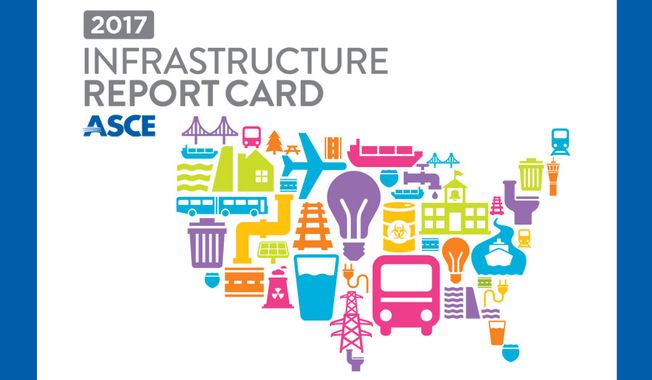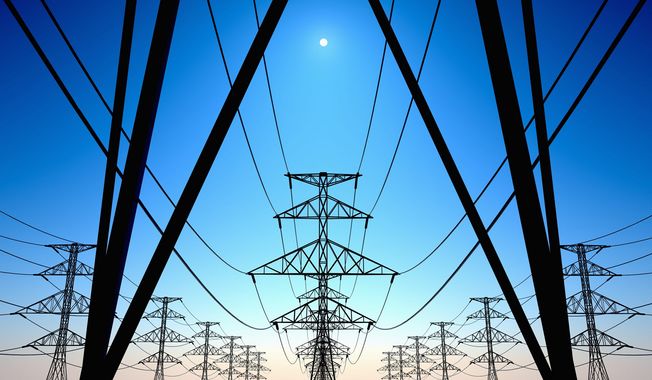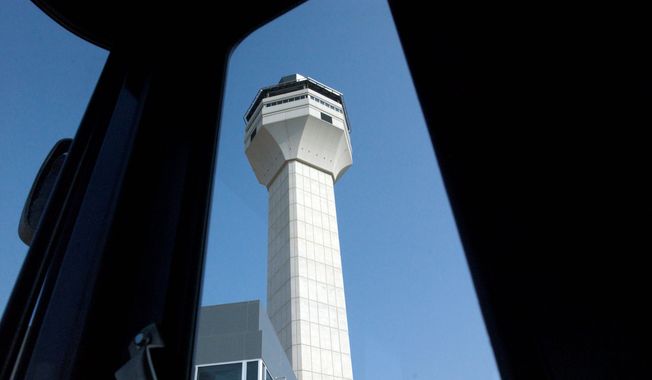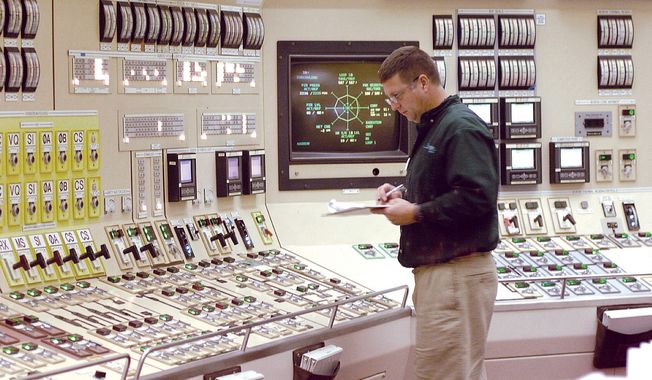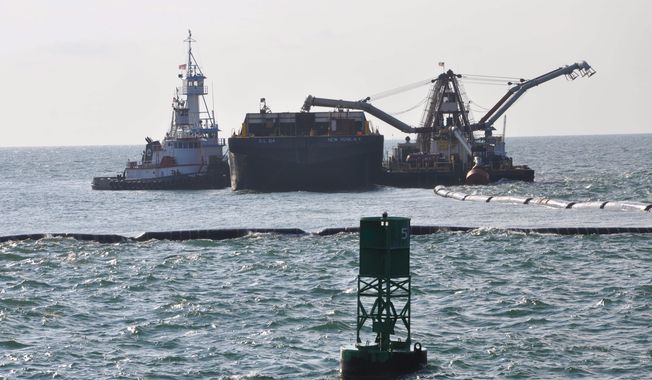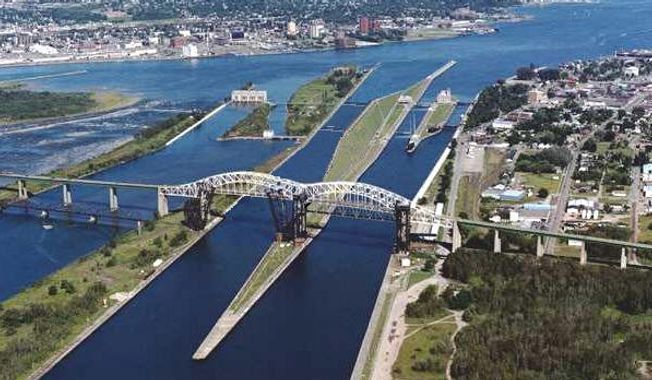Infrastructure 2017: Gearing Up and Going Beyond
"Infrastructure 2017: Gearing Up and Going Beyond" is a Special Report prepared by The Washington Times Advocacy Department.
Recent Stories
Time to get to work on infrastructure
Across America, we have aging roads, bridges, dams and water systems. Our crumbling infrastructure is threatening public safety, slowing economic development and costing us all.
U.S. public, politicians agree: Time to modernize U.S. infrastructure
The images of roads that have seemingly become rivers over the past few weeks in Houston are hard to fathom.
An infrastructure priority: Ensuring safe drinking water
When we hear the word "infrastructure," our minds often tend to think of highways, roads and bridges. While that's an important part of our nation's infrastructure, an often-overlooked component is our drinking water delivery systems. Just as roads and bridges create stable communities and economies, so does safe, clean drinking water.
Congress cannot squander a rare opportunity for reform
If you believe Congress should focus on cutting taxes for the American people, reducing the size of government, and ending decades of wasteful federal spending, then pay close attention to the House of Representatives in the coming days.
Time to free air traffic control from the federal bureaucracy
A major battle is under way to improve the air traffic control (ATC) system by removing it from the Federal Aviation Administration (FAA), the national air safety regulator. The reasons are many, including the fact that modernization of air traffic control technology and procedures is over budget, behind schedule and far less advanced than in other countries.
The infrastructure that drives America's future: Electric transmission
It's the most critical national infrastructure of all: our interstate electricity transmission system. This 700,000-mile network of high-voltage wires that crisscross the country feeding energy into our communities powers America's digital economy much as roads and bridges carry physical commerce.
Why Congress is the essential leader on infrastructure
The stately arrival of the infrastructure bill seems to be our country's Waiting for Godot moment — but is it going to move the needle in making our country great? Infrastructure is not simply roads and bridges, or wastewater treatment plants, or natural gas pipelines, or high-speed internet. To be sure, it is all of those things, but more importantly, when our citizens think about infrastructure, they are thinking of results, of benefits. They are thinking of health and mobility and opportunity — that greatness in all of those things underpinning and enabling what John Locke called "the honest industry of mankind."
Ready to rebuild
While attention to the nation's infrastructure comes and goes on Capitol Hill, the roads, bridges and water systems in all 50 states continue to deteriorate every minute of every day. With some members of Congress signaling bipartisan support for a serious infrastructure bill, we are at a crossroads.
Something we can all agree on
Improving our country's roads, bridges, tunnels and rail systems is a basic function of our government that has traditionally been supported by both parties. By investing in infrastructure, we not only repair deteriorating bridges, roads and tunnels, but also strengthen our communities and speed up commerce. It is one of the best ways to generate economic growth and create good paying jobs nationwide. As our country struggles with slow growth, I believe it is the right time for the federal government to make a significant investment in infrastructure.
Pioneering automated travel -- and learning along the way
America's population is growing faster than the infrastructure we routinely rely upon to meet our daily needs. The demand for roadway space in recent years has steadily outpaced the supply, and gridlock threatens both our economy and our quality of life.
Our national airspace is national, not private
On the morning of September 11th, 2001, Ben Sliney began his first day on the job as the new operations manager at the Federal Aviation Administration's command center in Herndon, Virginia. Within hours, Mr. Sliney made an extraordinary and gutsy call to ground 4,200 aircraft in flight across the United States — effectively shutting down U.S. airspace. The 9/11 Commission Report cites Mr. Sliney's decision as perhaps the decisive moment to restore control over one of America's darkest days in its history.
Congress shouldn't deputize airlines as tax collectors
As a conservative, it bothers me when politicians evoke conservative-sounding arguments to push for legislation that fundamentally is not conservative. One such case is a provision in H.R. 2997, the House version of the bill to reauthorize the Federal Aviation Administration (FAA). This provision would separate the nation's air traffic control (ATC) system from the federal government and establish an independent entity. At first glance, it looks like something I would be in favor of. Except this so-called "privatization" is simply a give-away to special interests.
Air traffic control privatization is an attack on rural America
In the ongoing and vociferous debate about air traffic control system privatization, after all the sound bites and ad campaigns, we are left with really one certainty. "Privatization" is simply an attempt by the airlines to shift taxes and reduce access for rural America.
Nuclear energy: The unsung hero of American infrastructure
"Infrastructure" is often thought of as the steel and concrete foundation of the economy, but there is a more practical definition: hardware that runs all the stuff we take for granted.
Energy infrastructure and a pro-domestic energy agenda
Modernizing the nation's energy infrastructure has been a focal point of the Energy and Commerce Committee in the 115th Congress. Americans deserve safe, secure and efficient energy that meets the needs of the 21st century economy.
Thinking anew about electricity infrastructure
All the innovation happening in the ways we produce, use and even store electricity in the decades ahead poses a big question: Do we still need to build traditional electric delivery infrastructure — i.e., electric transmission?
Lithium-ion energy storage: Key component of America's renewable energy future
One of the more interesting storylines in conjunction with the recent total solar eclipse in the United States was how it might affect power plants that rely on the sun to produce electricity.
Waterways investment -- and red-tape relief -- means more jobs, commerce, national security
When Americans hear the word "infrastructure," our vast intermodal transportation system likely comes to mind, with roads, airports and rails a common part of many people's daily experience.
Tax-exempt municipal bonds are essential to building American infrastructure
Electricity powers our homes, businesses and the infrastructure that makes our communities livable and commerce possible — street lights, airports, ports, subways, schools, hospitals, police and fire stations, courthouses, libraries and the like.
Thoughts on successful partnerships for infrastructure
President Trump's infrastructure plan appears to be facing headwinds, both within the administration and in Congress. On Capitol Hill in particular, many lawmakers have shown skepticism that the administration can reach its goal of generating $1 trillion in infrastructure spending over 10 years by speeding up environmental permitting and incentivizing companies to invest in projects in exchange for tolls or fees.
Deepening the Port of Savannah: A boon to economy -- and trade
A popular buzzword in Washington, D.C., right now is infrastructure and how we can get to our goal of seeing a plan finalized. As we continue to discuss an infrastructure plan, we must look beyond the traditional definition of "infrastructure" projects and include projects that add economic value, such as ports.
Michigan's Soo Locks: The urgent need for one more
Over the course of my lifetime, I've experienced the world through many different lenses: as a father, grandfather, small business owner, U.S. Marine and commercial airline pilot. Now as a freshman Congressman, I have the privilege of adding a new lens to my perspective. These first few months in Congress have enabled me to understand the broad scope of even the most complex legislation.
Sale of federal assets could yield billions for infrastructure
Potholes. Flight delays. Crumbling dams, spillways and bridges. The need for investment in our nation's infrastructure is glaring, and the deterioration has been occurring unchecked for years. For the first time in a long time, Washington is proposing an innovative and long-overdue infrastructure package that goes beyond just maintenance and is anything but status quo.
What infrastructure needs: Smart permitting
For years, members of Congress have criticized the federal infrastructure permitting process. While often justified, today's system is actually better and more efficient than it was 20 years ago. Still, there is room for improvement, and the Trump administration's main challenge is how to improve infrastructure permitting while ensuring that the result withstands the almost-inevitable court review.
Unlocking billions of dollars of infrastructure funding capacity
The nation's approach to managing public infrastructure is often inefficient. Best practices, such as life-cycle asset management and preventive maintenance, are rarely a priority. We can, however, unlock billions of dollars of infrastructure funding capacity now trapped in existing assets by improving how we build, operate and finance infrastructure.
Why U.S. must outpace China, other nations
Autonomous vehicles will usher in the single greatest change in society since the Industrial Revolution. For this change to happen, Congress will need to deliver to President Trump a national autonomous vehicle framework bill that includes vehicles weighing over 10,000 pounds.
The Ray in Georgia: Demanding more of roadways
The world is getting smarter. Smart phones. Smart cars. Even smart thermostats. Yet, we're still building the same roads that we were building in the 1950s. We need roads that do more than just get people from one place to another.
You get what you pay for
For years, there has been broad consensus that bold action is necessary to maintain and modernize our nation's infrastructure. Yet, like so many bygone policy battles, the challenge has always been how to pay for it. While Washington, D.C., often chooses to overcomplicate things, the simple solution is the right one: If you are going to use infrastructure, you need to pay to maintain it.
Public infrastructure for public benefit
The story of the growth of our nation — the expansion of 13 Eastern Seaboard states from sea to shining sea — is the story of infrastructure. It is the story of inland waterways, like the Erie Canal, and the Transcontinental Railroad. It is the story of the federal highway system of nearly a century ago and the interstate highway system created during the 1950s. And it is the story of the Hoover Dam and the Tennessee Valley Authority.
Broadening our broadband
Every day in cities across the nation people are having groceries delivered to their front doors after they have ordered online or through an app on their phone. Others are logging on each night to connect with friends, get an education or catch up with the news of the day. But in rural America, the picture is not the same. This difference has been dubbed the "digital divide."
Spectrum: The essential ingredient for America's broadband infrastructure
Typical discussions of infrastructure policy revolve around roads, bridges, pipelines, ports and the like. These are critically important assets to our country and providing for their maintenance and necessary expansion should be a priority for policymakers. But there is no question that broadband networks are similarly important infrastructure, and that they play an increasingly vital role in fulfilling America's economic and societal potential.
Spectrum is the next frontier for infrastructure
In the aftermath of a natural disaster, policymakers often turn their attention to the state of the nation's physical infrastructure. This no longer means strictly physical infrastructure, as broadband infrastructure is increasingly entering Congress' discussions. Policymakers should remember that broadband companies don't need vast, new subsidies — they mostly need forward-thinking regulators and invisible infrastructure: radio spectrum.




